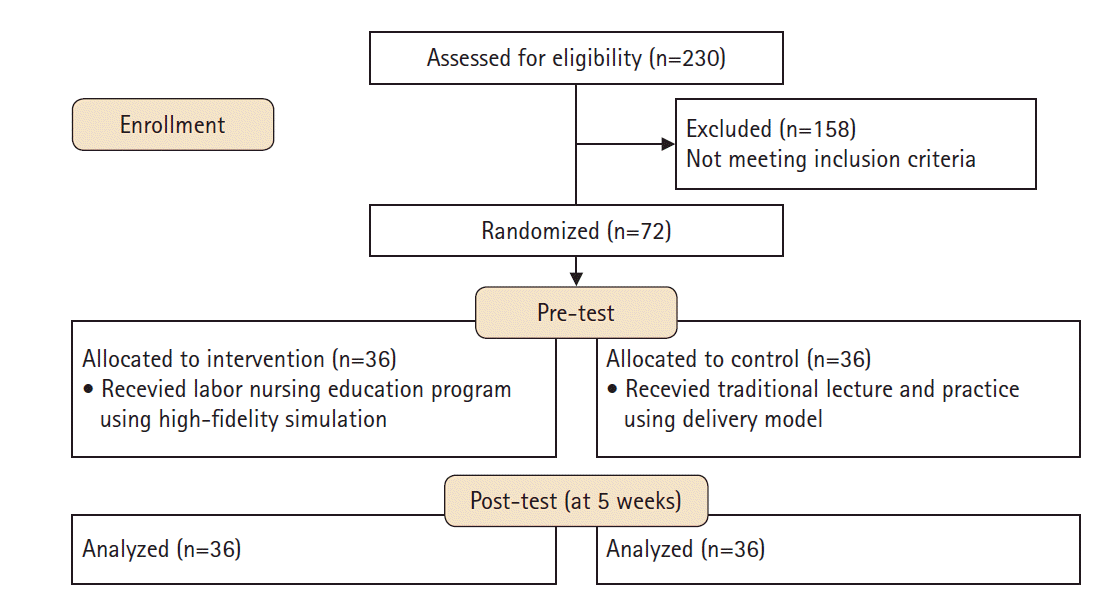1. Oermann MH, De Gagne JC, Phillips BC. Teaching in nursing and role of the educator: the complete guide to best practice in teaching, evaluation, and curriculum development. 2nd ed. New York: Springer Publishing Company;2017. p. 3–16.
3. Lee SO, Eom M, Lee JH. Use of simulation in nursing education. J Korean Acad Soc Nurs Educ. 2007; 13(1):90–94.
4. Kim Y, Chun N, Lee EH, Cho IS, Ahn S, Kim JI, et al. Student experience and satisfaction with clinical nursing practice in women’s health nursing. Korean J Women Health Nurs. 2011; 17(3):225–242.
https://doi.org/10.4069/kjwhn.2011.17.3.225.

6. Kim KA. Simulation-based labor education program on skill competence, knowledge, and satisfaction for education in nursing students [dissertation]. Seoul: The Catholic University of Korea;2014. 2–3.
8. Jeffries PR. A framework for designing, implementing, and evaluating simulations used as teaching strategies in nursing. Nurs Educ Perspect. 2005; 26(2):96–103.
10. Demirel G, Evcili F, Kaya N, Doğaner A. The effect of episiotomy repair simulation on the anxiety and self-efficacy levels of midwifery students. J Midwifery Reprod Health. 2020; 8(1):2050–2057.
https://doi.org/10.22038/jmrh.2019.42024.1479.

11. Bligard KH, Lipsey KL, Young OM. Simulation training for operative vaginal delivery among obstetrics and gynecology residents: a systematic review. Obstet Gynecol. 2019; 134 Suppl 1:16S–21S.
https//doi.org/10.1097/AOG.0000000000003431.
13. Song YA, Son YJ. Effects of simulation-based practice education for core skill of maternity nursing. Korean Parent Child Health J. 2013; 16(1):37–44.
14. Chung CW, Kim HS, Park YS. Effects of high-fidelity simulation-based education on maternity nursing. Perspect Nurs Sci. 2011; 8(2):86–96.
15. Kim A. Effects of maternity nursing simulation using high-fidelity patient simulator for undergraduate nursing students. J Korea Acad Industr Coop Soc. 2016; 17(3):177–189.
https://doi.org/10.5762/KAIS.2016.17.3.177.

16. Kim HJ, Lim JS, Choi SM, Park SH, Park SH, An SE, et al. Analysis of activities and services of delivery room nurses based on DACUM technique. J Korean Clin Nurs Res. 2015; 21(3):319–334.
https://doi.org/10.22650/JKCNR.2015.21.3.319.

19. Lee CM, So HS, Kim Y, Kim JE. An M. The effects of high fidelity simulation-based education on clinical competence and confidence in nursing students: a systematic review. J Korea Contents Assoc. 2014; 14(10):850–861.
https://doi.org/10.5392/JKCA.2014.14.10.850.

21. Yoon J. Development of an instrument for the measurement of critical thinking disposition: in nursing [dissertation]. Seoul: The Catholic University of Korea;2004. p. 69.
22. Lee WH, Kim CJ, Yoo JS, Hur HK, Kim KS, Lim SM. Development of a clinical competency measurement tool for student. Yonsei Nurs. 1990; 13(1):17–29.
23. Choi MS. A study on the relationship between teaching effectiveness of clinical nursing education and clinical competency in nursing students [master’s thesis]. Seoul: Ewha Womans University;2010. 36.
24. Korean Nurses Association. Nursing education learning objectives. Seoul: Korean Nurses Association;2012.
25. Kim HY. Maternity, newborn & women’s health nursing. 4th ed. Seoul: Hyunmoonsa;2018. p. 3–90.
26. Durham CF, Alden KR. Enhancing patient safety in nursing education through patient simulation. Chapter 51. In: Hughes RG, editor. Patient safety and quality: an evidence-based handbook for nurses. Rockville, MD: Agency for Healthcare Research and Quality (US); 2008.
27. Faul F, Erdfelder E, Lang AG, Buchner A. G*Power 3: a flexible statistical power analysis program for the social, behavioral, and biomedical sciences. Behav Res Methods. 2007; 39(2):175–191.
https://doi.org/10.3758/bf03193146.

28. Song YA. Effects of integrative simulation practice on nursing knowledge, critical thinking, problem-solving ability, and immersion in problem-based learning among nursing students. Korean J Women Health Nurs. 2020; 26(1):61–71.
https://doi.org/10.4069/kjwhn.2020.03.15.1.

29. Ackermann AD. Investigation of learning outcomes for the acquisition and retention of CPR knowledge and skills learned with the use of high-fidelity simulation. Clin Simul Nurs. 2009; 5(6):e213–e222.
https://doi.org/10.1016/j.ecns.2009.05.002.

30. Kim SO, Pak SY. Effects of high-fidelity simulation-based training of nursing students according to their learning styles. J Korea Contents Assoc. 2013; 13(11):1046–1057.
https://doi.org/10.5392/JKCA.2013.13.11.1046.





 PDF
PDF Citation
Citation Print
Print




 XML Download
XML Download